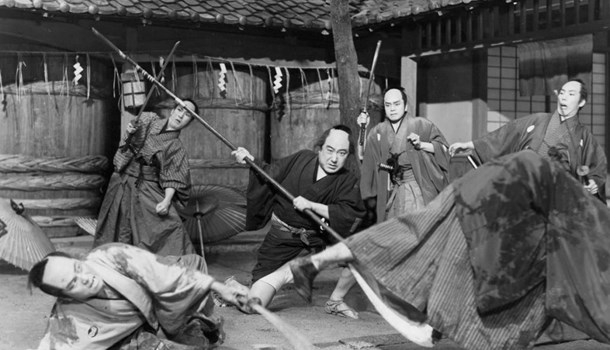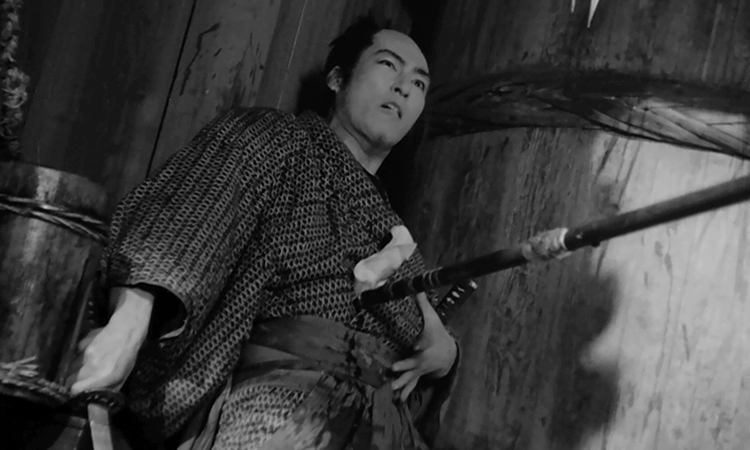
Written by Richard Durrance on 29 Sep 2023
Distributor Arrow Films • Certificate 12 • Price 15.99
Bloody Spear at Mount Fuji (1955) is an intriguing proposition. It's directed by Tomu Uchiuda, who also directed the 1965 feature A Fugitive from the Past, a film that is often considered one of the greatest Japanese films of all time. How does a film from the same director 10 years prior hold up?
I’d seen Bloody Spear once before but couldn’t quite remember it. Watching again I can see why, because you understand much of it on a surface level, but it feels as if something is missing, potentially something very profoundly rooted in Japanese culture. In this I feel it is like watching The Million Ryo Pot (1935), though you often smile wryly at what is displayed and can understand the highly universal aspects, there's something subtle missing in your understanding even though you appreciate and can relate to what you see. One such example in Bloody Spear at Mount Fuji is a scene in which everyone stops and are unable to pass a busy road, because some lords decide to have an open air tea ceremony and it would not be cultured to demand to be allowed to pass. Unfortunately the cause of their haste is a child with diarrhoea, the displeasing smell causing the lords to reconsider their choice to picnic – also the heavens open, perhaps a sign of divine displeasure. Yet we can relate to this as the idea of kowtowing to the elite still too often seems embedded in culture.
Spear carrier Genpachi is following his master, Kojuro, on a trip to Edo to deliver a cup carried by Genta. Along the way they cross paths with many travellers: a Shamisen player and her daughter; a man who must sell his daughter, Otane, to pay his debts; Tozaburo, who some think may be a notorious thief who is in the area; and if that was not enough the small orphan, Jiro, has taken a shine to Genpachi, because why can Jiro not also grow up to be a spear carrier?
A sense of the profoundly ludicrous frequently runs through the film, mixed with a certain pathos. These two currents run up against each other in continuing contrast, as is shown in Kojuro who is not an unkindly master- after all as we meet Genpachi he unhesitatingly provides his spear carrier with medicine for his blistered feet - yet when Kujuro drinks he turns into quite another man. But in many ways the film exists as a character piece; this is not unsurprising when you realise that Ozu worked as a consultant to the film. It has something of Ozu about it in that certain streak of quiet humanism that seems to characterise Ozu’s work. Some may live, some may die, and not always well and some may be praised by the powers that be for reasons not even those being praised can accept, yet there is always a sense of quietly humane justice, even if there is also considerable injustice.
But to me the justice and humanity always just about ekes through to victory in the film, and again in this it felt like The Million Ryo Pot, because both films also conclude in a way that is almost less of an ending, rather it recognises that this is a continuing story and it chooses to bow out at a sensible place to rest. This is no bad thing, especially for Bloody Spear at Mount Fuji because of how it allows its characters to flow in and flow out, paths crossing and recrossing. And within these encounters, you can see how lives could perhaps change. Genpachi could very easily fall for the Shamisen player and become a father to her daughter, as well as to Jiro though you also know this likely will never happen because he is a proud spear carrier, and the spear in and of itself is often the most absurd thing of all, far too large for the properties within which it needs to be brought and also the cause of a ludicrous piece of misplaced justice we shall see on screen. But perhaps it is not as ludicrous as why are our protagonists even travelling to Edo? Why, to deliver a cup. What a fine cup. It’s a classic MacGuffin but also one that the film often quietly mocks.
The tone, though very much rivetted into a culture, certainly transcends it with themes that anyone can understand. The same is true of many of the moral dilemmas, so though as a film it doesn’t feel as relevant as some others of the period, it is nevertheless always more interesting than it may seem at face value. It can also be visually arresting, and often in such a way as to suggest cultural connotations you rarely see. Kojuro, as he is pinned both by blades and by the camera into the tight space between vats of sake, feels almost downright iconoclastic.
The performances arguably have a smoothness that means they all fit together into a whole. And it’s how they work as an ensemble that matters because Bloody Spear at Mount Fuji seems more interested in provoking a tone, a sense of time and place and critiquing it while also perhaps believing in it. Is it a classic of Japanese cinema? It’s a strong contender, and in one way I support it wholeheartedly because seeing more films of the period showcases there are some utter delights out there which are not always easy, if possible at all, to see (at least readily translated). I don’t necessarily mean Jidaigeki (though I'll happily take more!) but I would welcome more releases that delve into the back catalogues. More films like Our Neighbour Miss Yae would be most welcome.
Oddly my biggest issue with the film is the cover art for it, because it makes the film look like a horror movie. I can see what they may have picked up on but really it's bewildering and originally put me off watching the film. Yet it is ultimately touching, human, funny and tragic.
More please Arrow.

Death as iconoclasm?

Long-time anime dilettante and general lover of cinema. Obsessive re-watcher of 'stuff'. Has issues with dubs. Will go off on tangents about other things that no one else cares about but is sadly passionate about. (Also, parentheses come as standard.) Looks curiously like Jo Shishido, hamster cheeks and all.
posted by Richard Durrance on 17 Dec 2025
posted by Richard Durrance on 12 Dec 2025
posted by Ross Locksley on 09 Dec 2025
posted by Richard Durrance on 28 Nov 2025
posted by Richard Durrance on 25 Nov 2025
posted by Richard Durrance on 18 Nov 2025
posted by Richard Durrance on 14 Nov 2025
posted by Richard Durrance on 11 Nov 2025